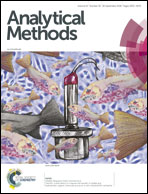A solid-state Sb/Sb2O3 biosensor for the in situ measurement of extracellular acidification associated with the multidrug resistance phenotype in breast cancer cells†
Abstract
Metal oxide-based pH sensors have received considerable attention owing to their advantages and potential applications in biomedicine, materials science, environmental science, and analytical science. The occurrence of multidrug resistance (MDR) hinders the efficiency of chemotherapy. In addition, a low extracellular pH (pHe), which is a common feature of the tumor microenvironment, contributes to resistance to chemotherapy. Therefore, in this work we demonstrate the facile fabrication of a solid-state Sb/Sb2O3 (SSO) electrode for high-performance pH sensing to monitor the pHe of two cell lines (MCF-7/ADR Adriamycin-resistant breast cancer cells and their MCF-7 parent cells). To achieve this aim, the electrode was prepared by melting antimony (Sb) in a U-type glass tube and subsequent oxidation via the molten sodium nitrate method. The fabricated SSO electrode was characterized by scanning electron microscopy, X-ray diffraction, and X-ray photoelectron spectroscopy. It was found that the SSO electrode-based pH sensor exhibited high performance with a sensitivity of −57.30 ± 0.60 mV pH−1 and a correlation coefficient (R2) of greater than 0.9966 in aqueous buffer solutions (pH = 2–12). In addition, the fabricated pH sensor displayed not only a short response time (about 2 s) but also long-term stability (pH deviation of <0.15 after three months). Furthermore, the differences in pHe between MCF-7/ADR and MCF-7 cells were determined by the fabricated SSO electrode, and MCF-7/ADR cells and MCF-7 cells maintained pHe values of about 6.83 and 7.02, respectively, after 12 h. The results showed that the fabricated SSO electrode could be used to measure differences in pHe and also used to monitor the metabolic activity of cells.



 Please wait while we load your content...
Please wait while we load your content...